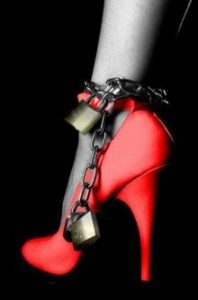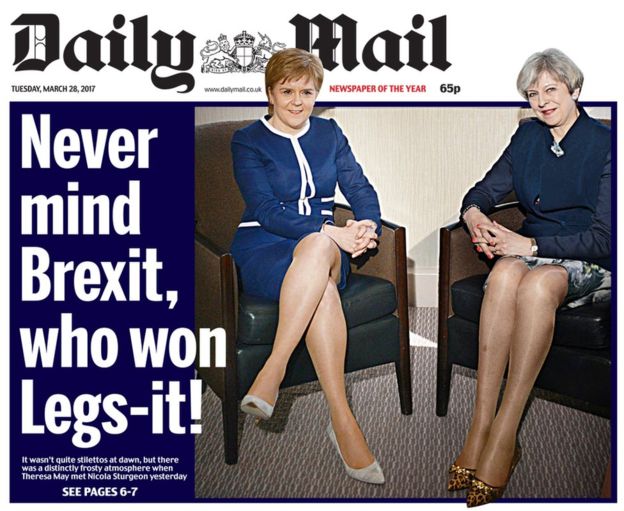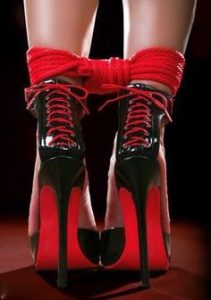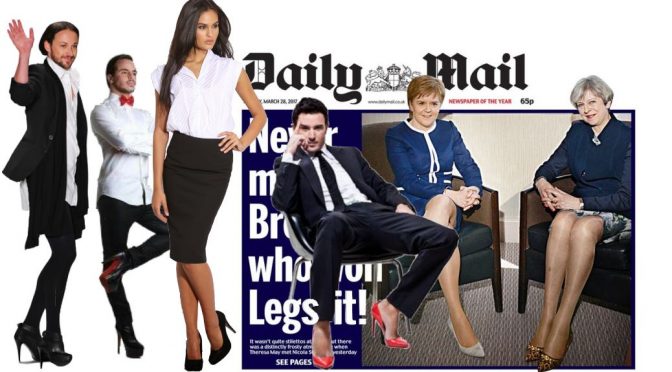Ban on sexist forced workplace dress codes abandoned
 The Government has backed down from enforcing a review of the law regarding workplace dress codes where they discriminate on gendered lines, such as requiring makeup, skirts and high heels for women but only clean shaven, suits and flats for men.
The Government has backed down from enforcing a review of the law regarding workplace dress codes where they discriminate on gendered lines, such as requiring makeup, skirts and high heels for women but only clean shaven, suits and flats for men.
“Forcing women to wear high heels at work is medieval – and no better than calling us witches” – The Daily Telegraph
Instead, the Government says that existing equality legislation is sufficient to the task so long as men are required to dress to an “equivalent level of smartness“.
Equivalent level of smartness
A Government spokesperson said:
“No employer should discriminate against workers on grounds of gender – it is unacceptable and is against the law. Dress codes must include equivalent requirements for both men and women.”
 Equivalent? What would that look like in reality if applied in the workplace or tested legally? Men in ballet pumps, cramping their feet and allowing them to stand en pointe to reach the tallest shelves at work? No baggy suits, only tailored ones to every pectoral muscle, firm behind or indeed bulge, looking like someone from the Chippendales before the striptease music begins? Perhaps, the phraseology should be an “equivalent level of sexualisation”.
Equivalent? What would that look like in reality if applied in the workplace or tested legally? Men in ballet pumps, cramping their feet and allowing them to stand en pointe to reach the tallest shelves at work? No baggy suits, only tailored ones to every pectoral muscle, firm behind or indeed bulge, looking like someone from the Chippendales before the striptease music begins? Perhaps, the phraseology should be an “equivalent level of sexualisation”.
Nicola Thorp, PwC and Piers Morgan
PricewaterhouseCoopers (PwC) briefly employed Nicola Thorp as a front facing receptionist temp, but sent her home when she came to work in flats not heels. It set off a petition attracting 150k signatures. When it came to her being interviewed by Piers Morgan on ITV’s Good Morning Britain she acquitted herself brilliantly against the sexist Piers Morgan who said:
“If you’re the gatekeeper to meetings and you’re taking very important clients with besuited guys (oh and er women and whatever)…is it actually sexist for the company to say ‘we’d like you to look fantastic as well and to look glamorous and wear heels and set a kind of whoah'”.
“Certain jobs, I don’t think it’s unreasonable for them (the employers) to say we don’t want you in flats showing visitors around.”
Thorp replied “High heels are designed to make women look sexier not more professional. Piers was rightly slammed by viewers after his sexist suggestions.
Piers donned a pair of silver high heels for an appearance on Loose Women afterwards, to which Twitter responded again:
piers morgan wears heels for like 10 mins while sitting down, sexism is over(!!!) https://t.co/ERZjaokDRS
— jayney ☀ (@jayney) January 30, 2017
High Heels Healthy?

Health and Safety alone would ban High Heels in continued usage, as indeed the NHS does. Evidence suggests that wearing them can lead to osteoarthritis.
“Wearing high heels when you go out in the evening is unlikely to be harmful. However, wearing them all week at work may damage your feet, particularly if your job involves a lot of walking or standing.” – NHS Preventing Heel Pain
“High heels aren’t glamorous, they are physically damaging and requiring women to wear them is sick” – The Daily Telegraph
Theresa May’s Kitten Heels
Theresa May’s footwear has long been noticed, and she is no kitten as her predatory early election calling has shown.
Even when paired with skirt suits and high cut tops, the Daily Mail‘s “Who won Legs-it” headline focus shows where the eye, the attention, and the comment goes…

Well heeled History
High heels were originally worn by men and women – of status, hence the expression “well-heeled” indicating wealth, and in Europe, at least, can be traced back to the 16th century. In the late 17th century “King Louis XIV of France decreed that only nobility could wear heels, and that only members of his specific court could wear red ones!” Christian Louboutin eat your heart out, or perhaps your ‘sole’.
Oppression or Empowerment?
 Why are high heels such a simultaneous symbol of oppression, femininity, power and domination? Can high heels be reclaimed as empowerment, not oppression?
Why are high heels such a simultaneous symbol of oppression, femininity, power and domination? Can high heels be reclaimed as empowerment, not oppression?
Like anything, it’s about choice. Feminism is about choice. Equality is about men and women having similar choices. Wearing high heels should be a choice – except on a hospital A&E ward or a building site.
